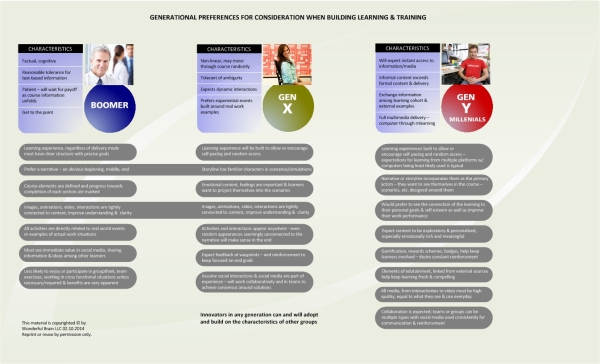When we last visited this topic about a week back I promised to create a visual—a chart of sorts—to encourage learning and instructional designers to consider how generational bias in training delivery. Just looking to start a conversation.
A Quick Review
You might want to pop back to the original article: http://tiny.cc/qpsrax
We know we’re engaging three distinct groups in today’s workplace, Baby Boomers, Generation X, and Generation Y (Millenials). Each has specific preferences for general communication and they carry over in training as well. Whether creating a training program when all three groups are in the room or accessing courses online demands the learning designer incorporate specific ways of delivering information with the appropriate assets, techniques, and technologies. Initially, we would hope learners, right from the first word or screen, slide or handout, would buy-in and see value; a predisposition that his will be a good experience. During the training, we build formative experiences to keep all groups interested and motivated to continue, committed that the investment in time is worthwhile. Finally we would want participants to exit the training experience appreciating it was translatable into their work life. If this is accomplished, the next training experience will be viewed much more favorably and meet with less resistance.
Acknowledging their generational age, and considering their technological age (how savvy are they to tech) as well as comfort with social media, influences how they will respond to courseware. Though there are three distinct groups, many learners exhibit the preferences for learning outside the generational ‘norm’. These people are to be commended for either learning new technology, appreciating other ways of ‘seeing’ learning or just curious enough to drop a toe in the fast flowing stream of change. We need to depend on these folks to help convert those who tend to be inflexible.
Caveats abound:
- This is not a fully scientific approach nor based on academic, androgogical research
- It is the product of crowdsourcing, anecdotal research and discussion with hundreds of learning/instructional designers and clients not to mention intuition
- My professional experience over thousands of hours of course building across more than twenty verticals and five geos and over 25 years of design have informed these findings, too
I am fully prepared to hear from all quarters. It’s a living document—a work in progress— so send your ideas to rshadrin@wonderfulbrain.com. I’m hoping criticism will help improve this instrument not merely tell me where to get off or how narrow-minded, oblique or stupid this exercise is.
Anyway, someone had to put a stake in the ground. Apparently me. I hope it doesn’t end up in my heart.
Ultimately, the learning designer has to make everyone happy if information transfer is to take place. Elements that ‘favor’ one group more than another will always be necessary. If knowledge, skills and behaviors are to be transmitted, absorbed and used than instructional design should seek balance. Occasionally this compromise is not appreciated nor well tolerated across the generations. Nevertheless, it is absolutely necessary to honor each aspect of the generation’s learning preferences and mitigate those that irritate others. Skillful designers know how to navigate these choppy waters and subtle mixtures of learning preferences can always be developed. Can the design ever be perfect. Well, no. But reasonable learners in all generations can recognize when attempts are made to entice them into a learning experience. And the organization expects each generation, besides tolerance, adapt as necessary to improve performance and solve problems through learning and training experiences.


Pingback: Overcoming Generation Differences When Building...
Pingback: CORPORATE INSTRUCTION IS STILL DISCONNECTED FROM MILLENNIAL LEARNING STYLES – A LIST BASED ON OBSERVATIONS IN THE WORKPLACE | Wonderful Brain